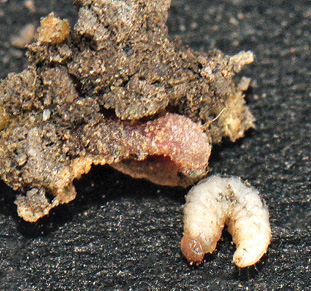Scouting should occur when crops have just emerged in the spring (Figure 8), especially when PLW populations are high. Look for the halfmoon leaf notches on the lowest leaves of the plant along field edges first (Figure 6).
To establish an average number of plants with leaf notches, scout fields and sample 10 seedlings per 10 sampling sites in the field: five sampling sites near the field edge and five sampling sites about 35 yards into the field (Figure 8). Space sampling sites in fields about 25 yards apart. Later in the growing season (late June and July) during flowering, dig up plants and examine root nodules for larvae or feeding injury (Figure 9) using a hand-held 10x lens.
Figure 8. Scouting for leaf feeding injury from pea leaf weevils in field peas
Figure 9. Larva of pea leaf weevil excised from root nodule.
During the summer, scout for newly emerged adult PLW in late July. Adult weevils are difficult to scout for because they can drop readily to the soil surface and are cryptic.
As pea harvest begins, adult PLW will migrate out of the field to feed on nearby legumes, such as alfalfa and sweet clover. These secondary hosts may harbor other weevils, such as the sweet clover weevil (Figure 5), that look similar to PLW.












